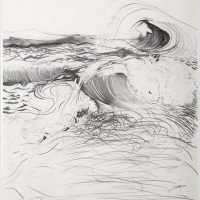223. BRETT WHITELEY

Few artists have engaged in such a passion for art and life as Brett Whiteley; few have absorbed, observed and painted their immediate landscape environment with such lucid expression, and yet engaged in the asphyxiation of a drug-fuelled urban culture on edge. For Whiteley, this life/art passion found its zenith in the act of drawing: whether directly with paint, with charcoal on canvas, or on paper, or even with the stippled brush of a pen and ink wash, he created graphic moving lines with a spiritual sensibility. All agreed that he could draw. He could activate an object in a painted ground with the merest flick of a lineso that even in highly finished studio paintings the drawn aspects still remained as a sophisticated delineation of the final image. His paintings of female figures in the 1960s were characterised by sweeping lines linked to the sexuality of body and limb; the lines enticed the viewer by the way that they housed the flesh, in outline, in diminutive steps and then bold arabesque exaggerations. The most striking output of the mid-60s was his series of bathroom drawings of his wife Wendy.1
The 60s had been a time swinging through London and the Hotel Chelsea in New York. Then, when he finally settled in Sydney late in 1969, true to his practice, he engaged his immediate environment. He and Wendy rented a house overlooking Sydney Harbour in Lavender Bay. He was again in proximity with the harbourhis childhood family home had been at Longueville near where the waters of the Lane Cove River and Sydney Harbour meet. So the scene was set for the creation of some of Australias most famous landscape works: the Lavender Bay paintings.
At the start of the 1970s, Whiteley was a member of the creative community of artists that Martin Sharp (1942-2013) had established at the Yellow House on Macleay Street, Potts Point. There he was an art world megastar with a bona-fide international reputation. His penchant for drugs and alcohol only increased the adulation of his adoring fans. Even so, he continued to focus on drawing, producing images of great lyricism from his harbour studio. Waves c1973, is an exceptional drawing from the climax of this period. It, along with similar works such as The Wave 1973, ink and wash on paper, are striking in their portrait formatthis arrests the viewer who may have expected landscape. Both images turn on a similar format: turn, with a wave curling left at the top of the image, with three simple marks in curvilinear traceries that activate our sense of the spume spray flying. The choice of a vertical format in Waves c1973 allows Whiteley to leave most of the surface untapped. Far from blank, the empty space is activated. The three lines of spray are the only marks that grace the sky but they carry the moving image.
Beneath this, a second wave breaks in the opposite direction, defying the physics of wave formation, yet paying homage to the restless roiling skies that van Gogh (1853-1890, Dutch) painted over his cornfields. It is the turbulent curling of the wave that speaks the truth of a troubled inner being. The lower half of Waves is haunted by more turbulence. Here, a thicket of restless lines running loosely parallel, move and fade, move and fade. At the heart of the picture there are breaking waves as white forms, sensitively curved, with drawing all around. Again and again with Whiteley, we see drawing used brilliantly to delineate form: these loose forms recall the curved body lines of Wendy bathing. Who could forget them? This is his intimate subject and love of his previous decade.
Footnotes:
- White, J., Brett Whiteley: Art, Life and the Other Thing, Australian Art Collector, vol.5, p.62
Professor Peter James Smith BSc (Hons); MSc; M Stats; MFA; PhD